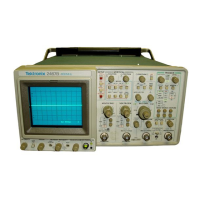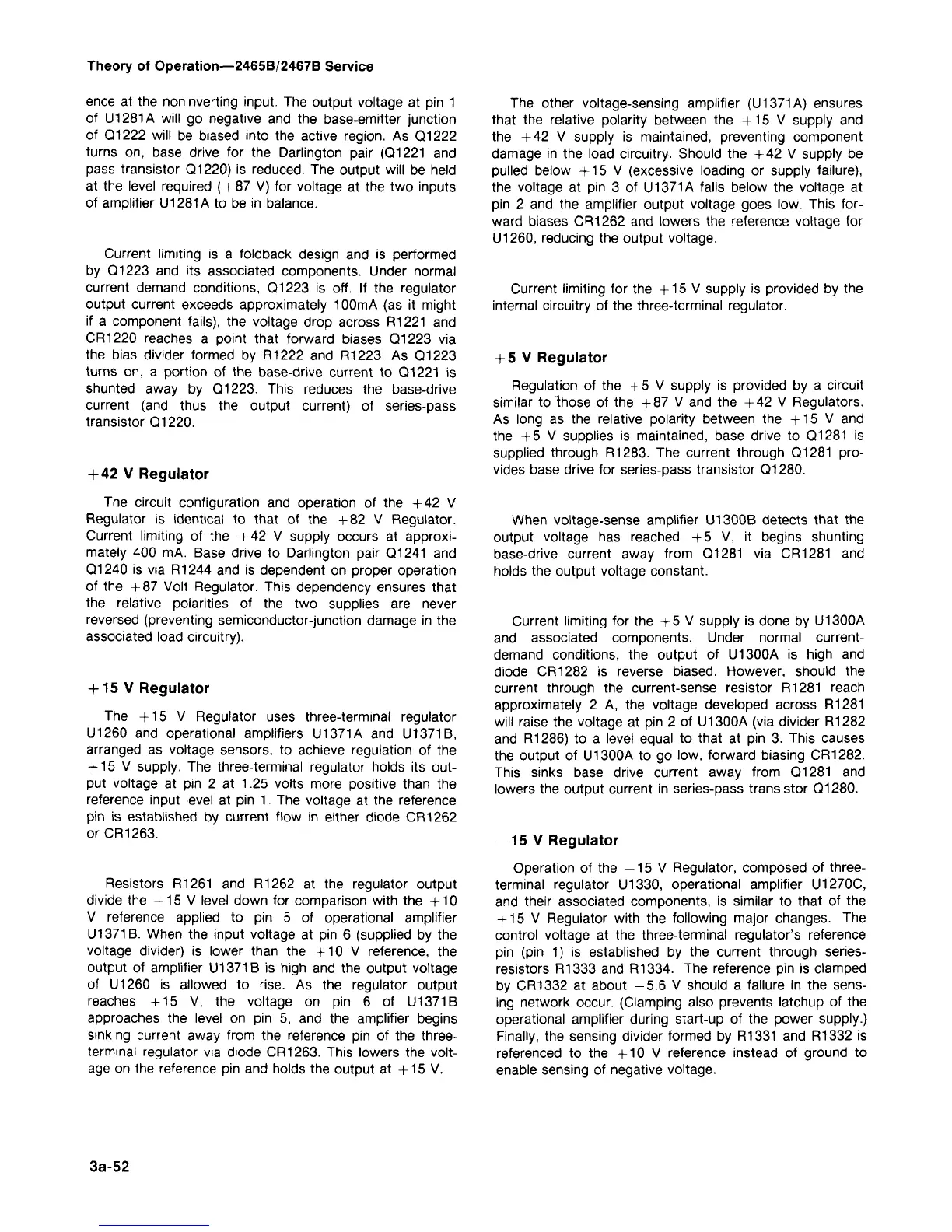Theory of Operation—2465B/2467B Service
ence at the noninverting input. The output voltage at pin 1
of U1281A will go negative and the base-emitter junction
of Q1222 will be biased into the active region. As Q1222
turns on, base drive for the Darlington pair (Q1221 and
pass transistor Q1220) is reduced. The output will be held
at the level required
(
+
87
V) for voltage at the two inputs
of amplifier U1281A to be in balance.
Current limiting is a foldback design and is performed
by Q1223 and its associated components. Under normal
current demand conditions, Q1223 is off. If the regulator
output current exceeds approximately 100mA (as it might
if a component fails), the voltage drop across R1221 and
CR1220 reaches a point that forward biases Q1223 via
the bias divider formed by R1222 and R1223. As Q1223
turns on, a portion of the base-drive current to Q1221 is
shunted away by Q1223. This reduces the base-drive
current (and thus the output current) of series-pass
transistor Q1220.
+ 42 V Regulator
The circuit configuration and operation of the +42 V
Regulator is identical to that of the +82 V Regulator.
Current limiting of the +42 V supply occurs at approxi-
mately 400 mA. Base drive to Darlington pair Q1241 and
Q1240 is via R1244 and is dependent on proper operation
of the +87 Volt Regulator. This dependency ensures that
the relative polarities of the two supplies are never
reversed (preventing semiconductor-junction damage in the
associated load circuitry).
+ 15 V Regulator
The +15 V Regulator uses three-terminal regulator
U1260 and operational amplifiers U1371A and U1371B,
arranged as voltage sensors, to achieve regulation of the
+ 15 V supply. The three-terminal regulator holds its out-
put voltage at pin 2 at 1.25 volts more positive than the
reference input level at pin 1 The voltage at the reference
pin is established by current flow in either diode CR1262
orCR1263.
Resistors R1261 and R1262 at the regulator output
divide the +15 V level down for comparison with the +10
V reference applied to pin 5 of operational amplifier
U1371B. When the input voltage at pin 6 (supplied by the
voltage divider) is lower than the +10 V reference, the
output of amplifier U1371B is high and the output voltage
of U1260 is allowed to rise. As the regulator output
reaches +15 V, the voltage on pin 6 of U1371B
approaches the level on pin 5, and the amplifier begins
sinking current away from the reference pin of the three-
terminal regulator via diode CR1263. This lowers the volt-
age on the reference pin and holds the output at +15 V.
The other voltage-sensing amplifier (U1371A) ensures
that the relative polarity between the +15 V supply and
the +42 V supply is maintained, preventing component
damage in the load circuitry. Should the +42 V supply be
pulled below +15 V (excessive loading or supply failure),
the voltage at pin 3 of U1371A falls below the voltage at
pin 2 and the amplifier output voltage goes low. This for-
ward biases CR1262 and lowers the reference voltage for
U1260,
reducing the output voltage.
Current limiting for the +15 V supply is provided by the
internal circuitry of the three-terminal regulator.
+ 5 V Regulator
Regulation of the +5 V supply is provided by a circuit
similar tolhose of the +87 V and the +42 V Regulators.
As long as the relative polarity between the +15 V and
the +5 V supplies is maintained, base drive to Q1281 is
supplied through R1283. The current through Q1281 pro-
vides base drive for series-pass transistor Q1280.
When voltage-sense amplifier U1300B detects that the
output voltage has reached +5 V, it begins shunting
base-drive current away from Q1281 via CR1281 and
holds the output voltage constant.
Current limiting for the +5 V supply is done by U1300A
and associated components. Under normal current-
demand conditions, the output of U1300A is high and
diode CR1282 is reverse biased. However, should the
current through the current-sense resistor R1281 reach
approximately 2 A, the voltage developed across R1281
will raise the voltage at pin 2 of U1300A (via divider R1282
and R1286) to a level equal to that at pin 3. This causes
the output of U1300A to go low, forward biasing CR1282.
This sinks base drive current away from Q1281 and
lowers the output current in series-pass transistor Q1280.
-15 V Regulator
Operation of the -15 V Regulator, composed of three-
terminal regulator U1330, operational amplifier U1270C,
and their associated components, is similar to that of the
+ 15 V Regulator with the following major changes. The
control voltage at the three-terminal regulator's reference
pin (pin 1) is established by the current through series-
resistors R1333 and R1334. The reference pin is clamped
by CR1332 at about -5.6 V should a failure in the sens-
ing network occur. (Clamping also prevents latchup of the
operational amplifier during start-up of the power supply.)
Finally, the sensing divider formed by R1331 and R1332 is
referenced to the +10 V reference instead of ground to
enable sensing of negative voltage.
3a-52

